Are you looking for ways to expand your online presence and reach…
A Free Guide To Running Facebook Ads For Shopify Store

Running Facebook ads can indeed be a great idea. It’s one of the best ways to get your products in front of more than 2.45 billion people worldwide, and it’s free.
According to a survey, 78% of Americans have discovered new products to buy while shopping on the platform.
As it turns out, you don’t have to spend a lot of money to get good results with Facebook Ads. A large part of this is because Facebook provides many excellent tools for targeting people, which we’ll talk about shortly.
Don’t be concerned if you’ve never used Facebook ads before. Instead, we’ll go over how this chapter will help in this section.
I’ll show you how to set up, run, test, and improve your Facebook ad campaigns.
Facebook Advertising Costs Overview
There is no set budget for Facebook advertising, so it doesn’t matter how much money you spend.
Ad spend can range from $5 to $50 per day, depending on your situation and how much you want.
Facebook advertising has costs, which you should make before deciding how much budget to spend. Therefore, it is critical to ensure that you spend the appropriate amount of money to achieve the desired results.

How much would you pay for someone to click on your ad? To get an idea of the costs, consider how much you would have to pay for each click.
According to WordStream, the average cost of a Facebook ad click is $1.72 for all types of businesses.

It is not the case for all industries. For example, Facebook ads for travel and hospitality businesses cost about $0.63 per click on average, but that’s just one example.
If your business is in a specific industry, your per-click costs could range from $0.50 to $2.00.
This is something to keep in thing: you should always take these averages with a grain of salt. This is because your costs will vary depending on what you want to do:
- Target audience
- Competition
- Daily and lifetime budget
A little more on each of these:
Target Audience
It costs more to reach people who fit specific demographic and psychographic profiles than to reach others.
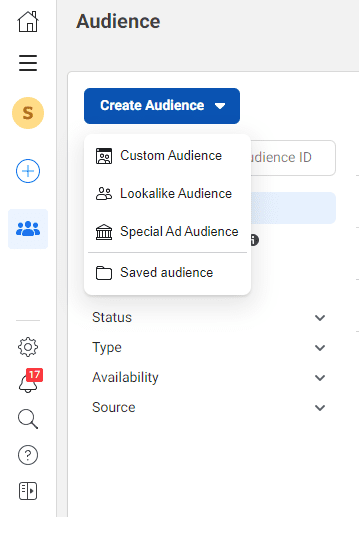
So, if you want to reach many people, your Facebook ad costs will be higher. So supply and demand are the same things in business!
As a result, you may want to cut your target audience to the number of people who could compete with you.
Then be aware. Because there are fewer placements or places where your ad can be shown, targeting a small group of people may be more expensive.
Competition
This may be the most important thing influencing the cost of your Facebook ads.
Why? Again, supply and demand come into play.
There would be no need for Facebook advertising if no other businesses attempted to reach your target audience and lower your costs.
Then, let’s get back to the point: the cost of your Facebook advertising will be determined by the number of competitors you have and how much they’re willing to spend.
Daily and Lifetime Budget
Numerous factors can influence the cost of your Facebook advertising, but there are two methods for determining this: your bid and your budget.
Your budget is the amount of money you are willing to spend on a single ad set or campaign.
Facebook also has two types of budgets:
- Daily Budget: This is the amount of money you’re willing to spend on a campaign every day.
- Lifetime Budget: This is the total amount you’re willing to spend on your campaign.
Your bid is the amount of money you’re willing to spend to secure an ad spot.

If you do not specify a bid, Facebook will determine one for you based on your budget and the length of your campaign.
You now know how much it costs to advertise on Facebook, so let’s look at what needs to be done before making your first campaign.

Facebook Ad Types
As you may know, Facebook purchased Instagram in 2012; put another way, you can manage ads for both Facebook and Instagram from the same Facebook Ads Manager.
So the point is that there are numerous types of advertisements from which to choose. Let’s take a look at the three most popular:
- Image and video ads
- Carousel ads
- Story ads
Image and Video Ads
These are ads that feature images and videos.
People see them in the same way that they see organic posts from other people, so your ads can be front and center when they see them. An image ad includes an image, whereas a video ad includes a video.
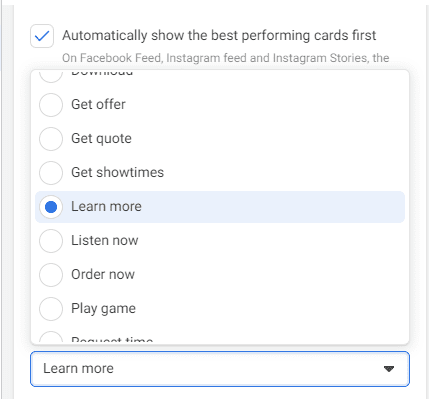
In these ads, there is a “call-to-action” (CTA), which is a button that asks users to do something, such as:
| Call To Action | Call To Action |
|---|---|
| Shop Now | Learn More |
| Book Now | Watch More |
| Contact Us | Send Message Listen Now |
Carousel Ads
A carousel ad works the same way that organic posts with multiple images or videos. For example, you can show up to ten images or videos per post with these posts.
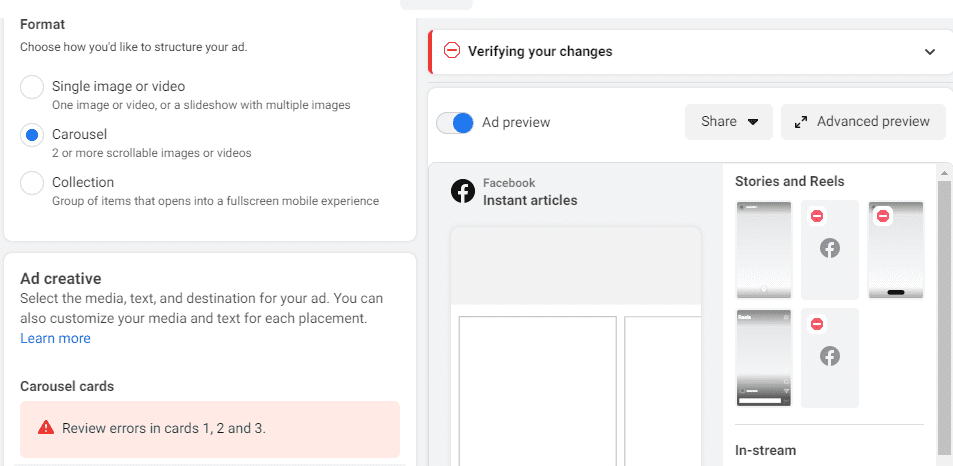
They show in a user’s feed alongside other posts. People will appreciate that you can direct your users to a unique link to each thing.
These can show off a few items on sale and entice people to visit your website to buy them or show many photos.
Story Ads
Your brand can use creativity to make your story ads more appealing to your customers. Story ads are immersive, full-screen units that allow your brand to do this.
In Kenshoo’s quarterly trends report, they spend more and more money on Story ads. Their spending increased from 9% to 18% in the second quarter of 2019, a significant increase.

Story ads appear in the middle of a person’s Stories when they follow them on Facebook or Instagram. They can make a good impression on potential customers. They also have a call to action at the bottom.
To make money with Story ads, create a campaign that promotes your product or service, including a call-to-action at the bottom to entice people to buy from your company.
You’ll be able to put ads with either an image or a video. Make sure your Story is visually appealing so that people who swipe quickly can read it.
Get to know Facebook’s Ads Manager.
In this segment, we’ll first explore Facebook’s Ads Manager. Then, we’ll show you where the buttons are and how the important things work.
Then, we’ll install your Facebook Pixel in place as well. Don’t forget to update your Pixel to ensure that your ads work correctly!
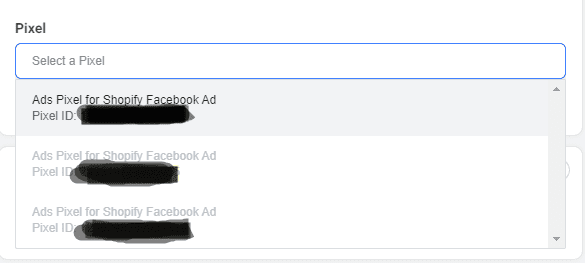
To set up & manage your ads, you’ll need to go to your Facebook Ads Manager. Then, when you last created a business page, Facebook created an Ads Manager account for you.
If you have a Facebook account, you can access it through the tab on the left side of your profile.
You can also get to it by going to the Settings menu. Then, open it by clicking the small arrow in the top-right corner of your screen and then selecting “Manage Ads.”
Research Your Audience
Discover what your target audience likes and dislikes.
There are numerous sections in the Ads Manager menu. To find out who to target, go to the “Plan” section and select “Audience Insights.”
The Audience Insights tool provides information about any targeting metrics you choose.
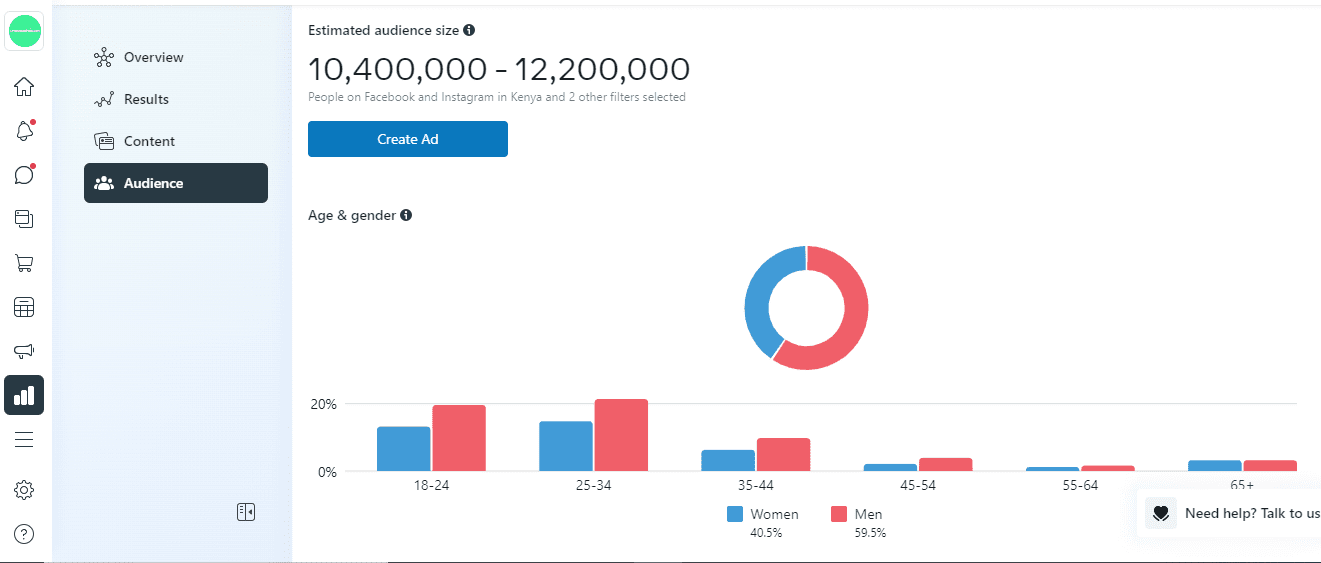
One of the options available to you is to select an audience.
Don’t limit yourself to generic interests like nature, sports, or food. Instead, pick specific ones, such as relevant brands, authors, books, websites, or other Facebook pages.
Use the results to make business decisions. For example, you can run more masculine ads if most of your customers are men. So, if they like a particular product, you could put it on your store and run ads for it.
Assume I want to sell camping gear. I can go to “Outdoor recreation” under Interests. Then I can choose camping from that list of options.
Many people on Facebook like camping and are between the ages of 25 and 34 and account for approximately 27% of all Facebook people who go camping.
Hack!
Audience Insights includes a “Page Likes” tab that shows what your audience enjoys. You can tell which pages they like by looking at this. Because many people who “like” your page also like another page, you can create ads for people who like that page.
When you’ve made a list of potential interests, click the “Save” tab and give your audience a name. Then, click the “Save” button to the right at the bottom. This will save the audience of people you’ve selected in the Audience Insights tool so you can use it again. Audiences from your Ads Manager will then show in that area.
Facebook Pixel
The first step is to install the Facebook Pixel on your website.
Facebook Pixel: A small code on your website pages to track what users do while there. The Pixel collects information about your visitors, such as what they bought and which pages they visited, so you can figure out how to improve your site.
Consider the Pixel a “smart” tool that learns more about people who are more likely to buy. The tool will then show your ads to people who share those characteristics. This is how it works.
Let’s set it up right now.
Go to Facebook Ads Manager, click “All Tools,” and choose “Pixels.”
Go to Facebook Ads Manager, click “All Tools,” and choose “Pixels.”
It should be named after your store, in my opinion. The next step is to click “Create.”
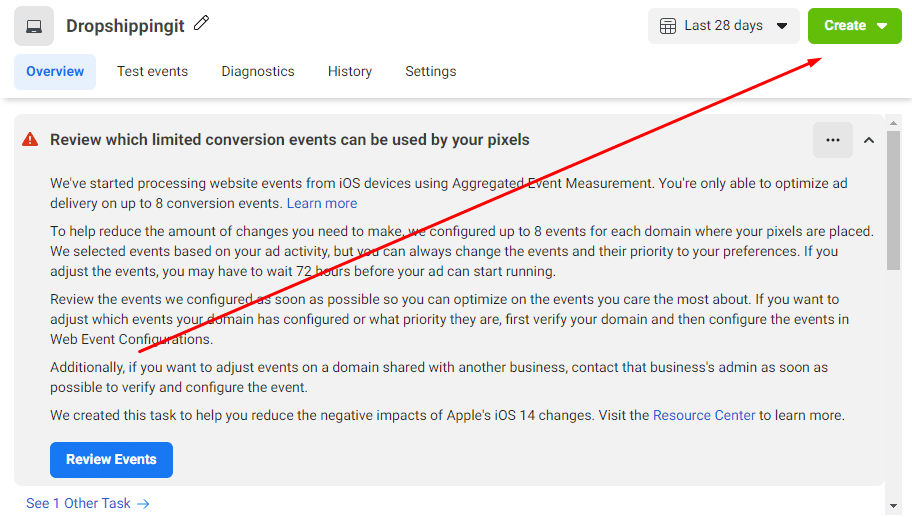
It will then be asked how to install it. Isn’t Facebook creepy? If you are logged into Shopify in the same browser, it will recognize you. Make sure that you select “Set Up Using Shopify (online).”
It will provide you with your Pixel ID, which is a code. This is how you obtain your Pixel ID: To copy and paste the code, go through the following steps:

- sign in to your Shopify account.
- Select “Sales Channels” and then “Preferences” in the admin area after logging into your account.
- Locate the “Facebook Pixel” field in the “Google Analytics” section of the page.
- Enter/paste the Pixel code
- At the bottom of the screen, click “Save.”
Hack!
Use Facebook’s “Send test traffic” feature to operationalize the Pixel. To send test traffic, enter your store’s URL, click “Send test traffic,” & wait for the little red dot that reads “No activity yet” to turn green. Then, when the red dot turns green, click “Continue.”
And you’re ready to go!
Set Up Your First Campaign
To start a new campaign in Facebook Ads Manager, navigate the “Campaigns” tab and click “Create.”

Choose from a list of campaign objectives right away. You can select from the following:
Using Facebook advertising to promote an online store? You should select “Store traffic” or “Conversions” because that is what Facebook will try to help you get more website traffic or website conversions.
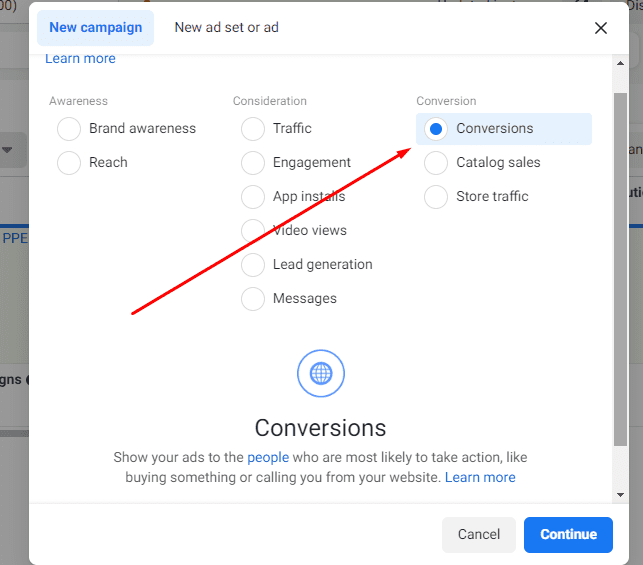
Conversion: A conversion occurs when a web user achieves one of your objectives. People can achieve this goal by clicking on your ad, signing up for your newsletter, adding an item to their shopping cart, or purchasing a product from your store. This goal may be pretty broad.
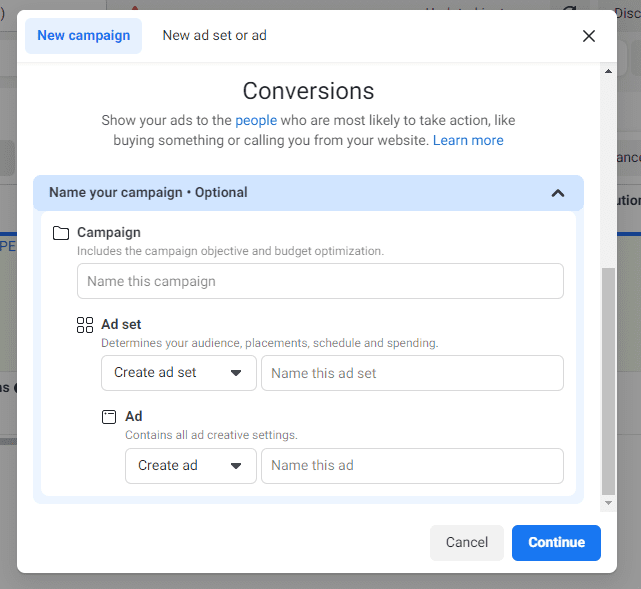
Add a name, enable “Campaign Budget Optimization,” configure the daily budget, and click “Continue” to proceed.
I think the new Campaign Budget Optimization (CBO) feature is fantastic. You can set a budget at the “campaign level” rather than the “ad set level” when you do it this way.

CBO examines your most effective ad sets and directs your budget to those that do. It does that one at a time for the best results. CBO also works with your bid caps and spend limits for each ad set to ensure that they match.
Remember that CBO may not divide your budget evenly among the ad sets. Even if you have three campaigns running simultaneously, one of them may spend most of your money on the first one if it is performing well. It will, however, not spend more budget than you can afford on a daily or long-term basis.
CBO saves you time by determining where your budget should focus.
Define Your Conversion Event
Before you start, decide on your Conversion Event.
Conversion events tell Facebook where you want people to come from so that they can send them to your website.
It is critical to select “View Content” as the goal at the start. If you do this, Facebook will show your ads to people who are most likely to click on them and visit your store.
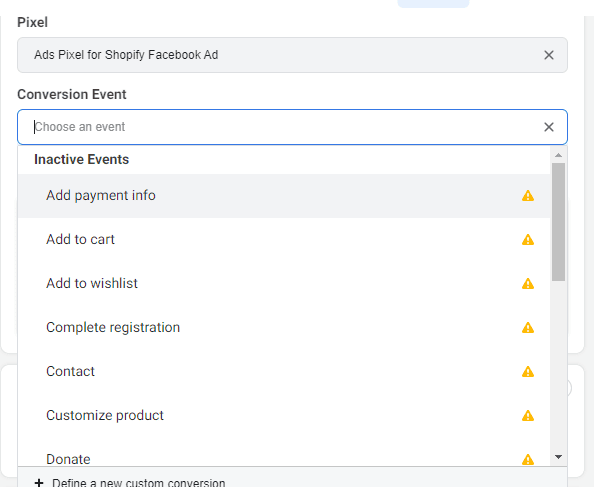
Once the Facebook Pixel has gathered information about what people do on your website, use either “Purchase” or “Add to Cart” as the conversion event for people who buy something. This instructs Facebook to show your ads only to people who are most likely to buy your products, ensuring they are seen.
Hack!
The Facebook Pixel may take several weeks to collect and show information about how people interact with your site.
Your Audience, Budget, and Schedule
Choose the audience, budget, and schedule that are most appropriate for you and your business.
The next step is to determine who your target audience is.
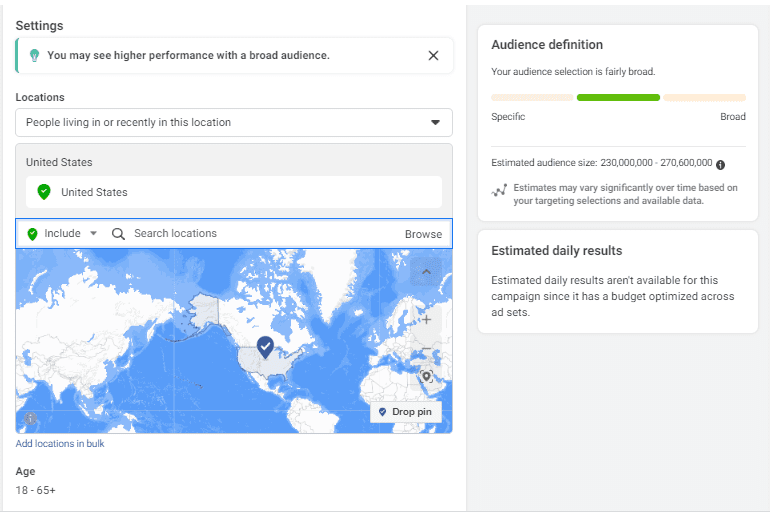
You can use Facebook to target specific groups of people based on their habits and interests. For example, “Detailed Targeting” is where to put one or a few things you’ve already found. For example, a supplement store could list “protein shake” as something they want to sell.

You can create a new audience from scratch or use the one you made with the Audience Insights tool to create a new one.
You can change your targeting if you do it while making an ad. This feature will assist you in getting your ads in front of more people when they are likely to perform well.
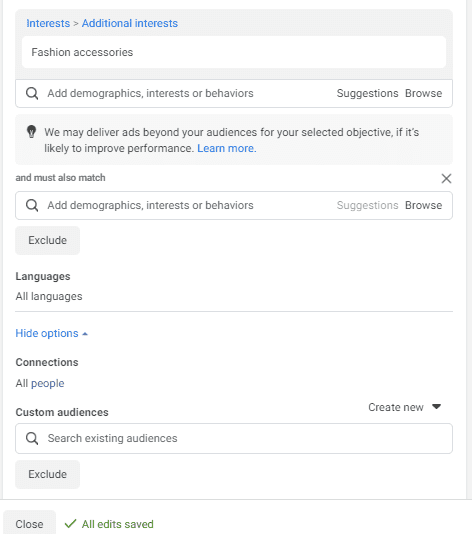
When you use Custom Audiences, you can reach out to people who have expressed an interest in your store.
To create a Custom Audience, set these steps:
- Log in to your Facebook account and navigate to the Facebook Ads Manager.
- Select “Audiences.”
- Click “Create a Custom Audience.”
Then, from the list of possibilities, concentrate on people who have previously visited your website. You can also reach out to people who have looked at specific products on specific pages. This type of process is known as “retargeting.” When people visit your store, you can use retargeting to remind them of previously viewed things.
One thing to remember is that the Facebook Pixel should be placed on your website. Without it, Facebook will not be able to collect information about people in your business. So before attempting to create a Custom Audience, make it to see if it has been installed.
Hack!
A Lookalike Audience is another fantastic type of audience. This allows you to target people who share the same characteristics as your Custom Audience so that you can reach out to them as well.
Create a Custom Audience
It’s almost the same as making a group of people who look like you. Just select “Lookalike Audience.” If you don’t know who your best customers are, you can skip Lookalike Audiences for the time being. They are only effective if you already know who your best customers are. Later, when you’re looking for new ways to improve your campaigns, use them as a guide.
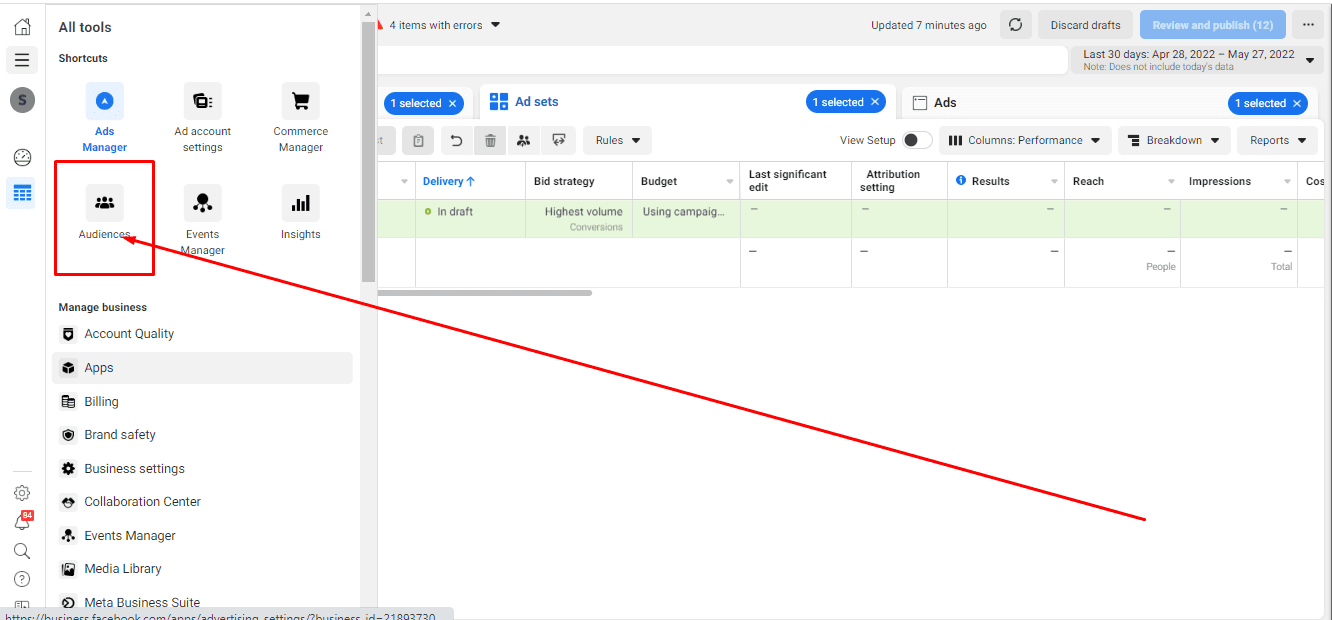
Finally, you’ve found a receptive audience. For example, Facebook will ask you how much money you want to spend and how frequently you want your ads to appear.

You wouldn’t have to do Anything if you enabled Campaign Budget Optimization from the start. Remember that most people begin by setting a daily budget of $5 to $10.
You should also change your bid strategy to “lowest cost.” This will instruct Facebook to spend your entire budget to get the most clicks at the lowest possible cost, which is precisely what you should do.
You can run your ads for a set period or indefinitely. If you decide to select start and end dates for your Facebook ads, you can always change them.

To see more options, click “Show more options,” then select “Link Click (CPC)” from the “When you are charged” drop-down menu.
Once you’re satisfied with the budget and schedule, you can move on to the ad design.
Design Your Ad
An ad can be made from scratch or from a post that you’ve already put on your page; these are the two ways.
Again, decide whether you want to use a single image or video in your ads or a collection of images and videos—also known as carousel or multi-product ads, as well as collections.
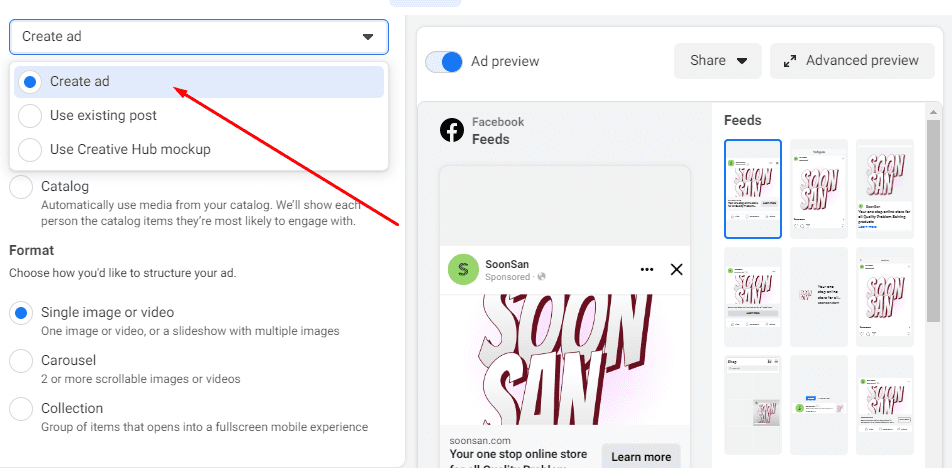
Because this is your first campaign, keep things simple. First, select “Single Image or Video.” Then, once you’ve gotten used to it and know what to look for and improve your performance, you can go crazy with more complicated ads.
Make a video because they’re a great way to get people making about your content. Our guide on making product videos contains a wealth of information to assist you in getting started.
Guru-Inspired Insights
This is where you fill out the details of your ad. You can Add after uploading an image or video the following:
- Text: This is the main text of the post. Link the button to the URL on your website, but you should include a shorter version of the same link in the email body. You can use bitly for this, and it will work.
- Website URL: This is the page you want to link to. This page should reflect the content of your ad, or your ads will not perform well.
- Headline: Next to the ” click to start ” button, your headline will appear below your image or video, next to the “click to start” button.
- Call-to-action: This is where you specify what the button will say.
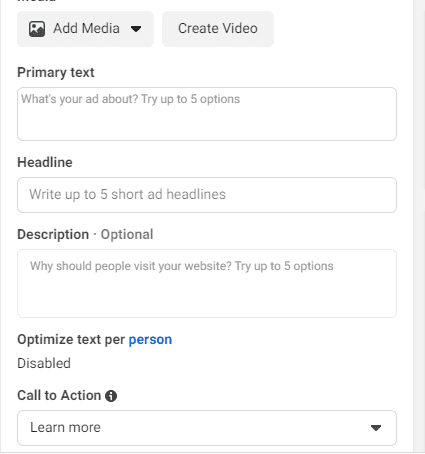
When you’re finished, scroll down and click “Confirm.”
Bravo! You’ve just started your first Facebook advertising campaign.
Leverage Your Ads Data
Make the Most of Your Ad Data
Even better, use the information gleaned from your ads to improve your performance further.
Create ads in your Ads Manager and let them run for a few days. Then look how well they worked you. Finally, you must look at this data if you want to make your campaigns in the future.
Run ads if you don’t know how well they work. It doesn’t make sense, does it?
When you look at your Facebook Ad data, you can see what isn’t working. And you can use that data to improve your campaigns for the next time and the next time and the next time and the next time and the next time and the next time and the next time and the next time and the next time and the next time and the next time and the next time.
As an example, you could say.
Assume you spent $100 on Facebook ads and received five sales. That means you spent $20 every time you sold something. You should try to make progress with each ad you run.
If you look at your Facebook Ad data and use it to plan your new campaigns, you can optimize your ads more effectively and spend less money on each sale.
If you use your data, you could pay $15 or even $10 for the sale, which is a lot of money. So keeping a profit or investing in your business means you will have more money to work with or save.
Hack!
With Facebook Ads, there can be much work and many mistakes. You’ll need to figure out the right balance of creativity, targeting, and money for your Facebook campaigns. Even if all of your campaigns are fantastic, there’s a chance that no one wants to buy the product you’re advertising.
To get the most out of Facebook Ads, you must be patient and willing to learn about them. Keep an eye on your analytics data, learn best practices, and change your campaigns frequently to achieve the best results. Please, don’t give up!
Understanding Key Metrics
Metrics are imperative to grasp fully, so you should be well-versed in them.
Let’s start with the most critical metrics:
- Reach: How many people saw your ad in their feed.
- Link clicks: The number of times a link in your ad was clicked.
- Impressions: The number of times your ad was displayed in someone else’s news feed is referred to as its impressions-this count will be higher than your reach if some people saw your ad more than once.
- Frequency: The average count of times each person has seen your ad.
- CTR (click-through-rate): The number of times someone saw your ad and clicked on a link.
- CPC (cost per click): This is the average price you pay for each link that someone clicks on.
Aside from CPC, Facebook shows you how much it costs each time a customer adds an item to their cart cost per cart.
“Checkout initiated” and “cost per checkout initiated” are two terms you can use to check if someone begins but does not complete checkout.
Here are some optimizing pointers to consider for your first ads:
- Don’t be concerned if you don’t make any sales on your first try. Your Facebook Pixel is getting ready and gathering information about people early on. People who see your ad will tell you how many people saw it and how many clicked on it. While the Pixel is doing its job, this will help you determine if your targeting and ad creatives are on the right track.
- In this work, you can use CTR to determine if you’re targeting the right people or if your ads need to be changed because people didn’t find them appealing. You might have a small audience who doesn’t want to see your ad. Experiment with broadening your audience. If you already have a large audience, try changing the text and images in your ad to make more people click on it and increase your CTR.
- To measure your “bounce rate,” divide the number of people who see your content by the number who click on links within it. If your bounce rate is higher than 55%, you should try to improve your landing page. You should make sure that your ad links directly to the product page for the item you’re promoting & that it’s clear what your product is for people who land on the product page.
Find Your Data in Ads Manager
How do you find your data in Ads Manager?
People who run campaigns can see how well they’re doing by viewing their campaigns in the “Campaigns” tab. In this section, you can look at a section of important data in the Ads Manager.
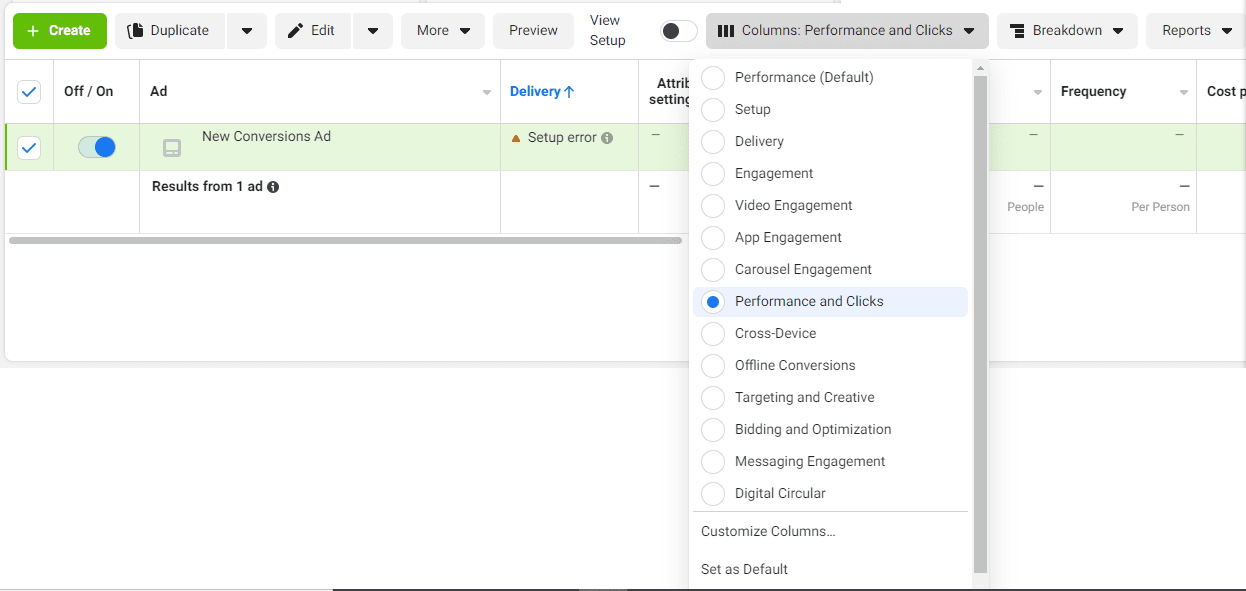
Click “Columns” from the drop-down menu. You can also change the metrics that appear. For instance, you can check the Performance & Clicks report to see how the ad performs.
Hack!
Chapter 10 will be landing soon, and we’ll give you more tricks of the trade on how to keep your ads improving.
Read Also:
- How To Grow Dropshipping With Social Media Marketing (2022)
- How To Create A Memorable Dropshipping Brand In 2022
- How To Choose Products And Suppliers For Dropshipping (2022)
- How To Select Niche Markets For Dropshipping Store In (2022)
- How To Create Product Pages That Convert Into Sales 2022
It’s also a good idea to check your Facebook ad campaigns in a variety of ways:
You can quickly look at your results using Breakdown by different groups.
You could look at age, gender, and placement to see if any hidden gems worked well.
Age: Look for the best-performing age group and focus your entire campaign on that age group only. If many age groups perform well, you could segment them into different ad sets to break the results.
Gender: It doesn’t matter whether you sell to men or women. Don’t focus on the other gender if you notice that one is more likely to buy your products.
Ad Placement: If your customers are more likely to buy products on a computer or a smartphone, find out where they buy them. Examining the placement breakdown metrics is the best way to determine which locations aren’t working.

Find those opportunities and concentrate on the most effective outcomes.
We also have a resource guide on checking the results of your Facebook ads here.
Here’s a valuable heads up about Facebook’s advertising policies.
Facebook scrutinizes every ad to ensure it does not break its advertising rules. If your ads contain any inappropriate content, they will be rejected. Some of the things you can’t say are:
❌ Tobacco and related tobacco products
❌ Items that are either illegal or fictitious
❌ Supplements that are unsafe or dangerous.
❌ Adult products
❌ Anything that makes health claims
Facebook doesn’t like it when there’s too much text in an ad image. However, the text in your images should not make up more than 20% of the space. The good news is that using the Facebook Image Text Check tool makes this simple.
The rules for video ads and how to target people can also be found on Facebook’s Advertising Policies page, which you can read in full.
It’s done! These are a few foundations that will start you gaining more people to your store and making some sales using Facebook ads.
It’s time to follow the steps above and start your first successful Facebook ad campaign by pursuing them.
Start Shopify For Only
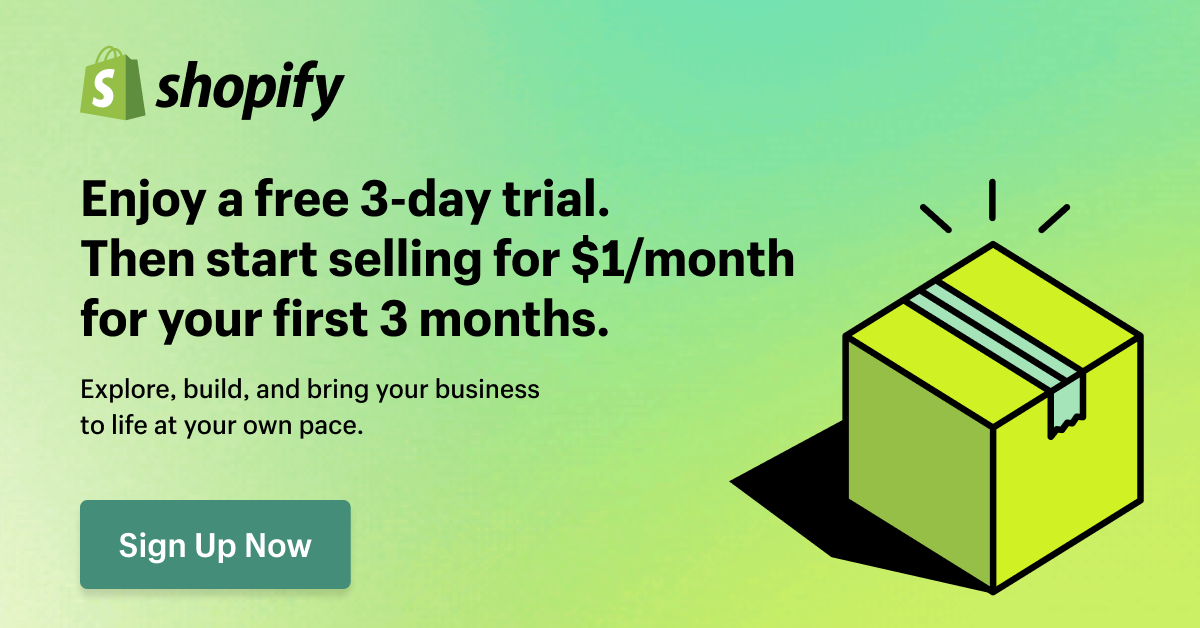
Try Shopify free for 3 days, no credit card is required. By entering your email, you agree to receive marketing emails from Shopify.

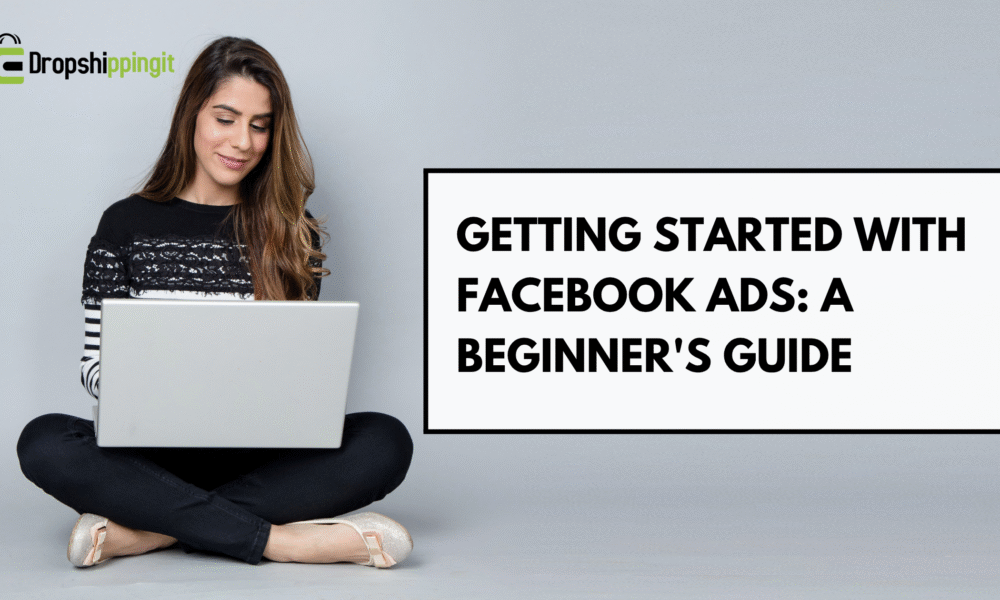


Comments (0)